Unlocking AI Potential through Prompt Engineering
G Jyothsna

Introduction
AI and large language models (LLMs) are transforming industries. Working with LLMs for code generation and creating prompts for various chatbots has deepened my understanding of prompt engineering from both the prompt engineer’s and developer’s perspectives.
Mastering prompt engineering is the key to unlocking the full potential of AI in software development. By learning how to create precise, detailed, and context-aware prompts, you can significantly enhance the quality of code, optimize development workflows, and leverage AI responsibly across a wide range of applications.
The objective of this blog is to explore essential prompting techniques and their impact on improving AI performance. We will also discuss the challenges and ethical considerations in prompt engineering. Mastering these techniques will empower you to harness the true power of AI effectively and responsibly in various applications.
What is prompt Engineering?
Prompt engineering is all about learning how to communicate effectively with AI to get the best responses. It’s about experimenting with different ways of phrasing questions and instructions to make the AI work smarter for you. By tweaking your prompts, you can guide the AI to focus on specific details or adjust its tone and style. This helps maximize the accuracy and relevance of the output, making AI more useful in various tasks.
Why Prompt Engineering Matters?
As AI continues to shape industries, from content creation to customer service and data analysis, prompt engineering becomes essential for unlocking its full potential by giving it clear, specific instructions. The more precise your prompt, the more relevant and accurate the response will be. It’s about saving time and avoiding frustration, and it enables you to fine-tune its output, adjusting tone, creativity, and detail. As AI continues to evolve, mastering prompt engineering will make you more efficient and effective in working with powerful AI tools.
Components of a Good Prompt:
A well-designed prompt should have the following components:
Instruction: A specific task or instruction you want the model to perform.
Example: “Summarize the article below.“
Input Data: The input or question that we are interested to find a response for.
Example: “Article: Rising temperatures are affecting agriculture globally…”
Context: External information or additional context that can guide the model to better responses.
Example: “The article is about climate change impacts.”
Output Indicator: The type or format.
Example: “Provide the summary in 3 bullet points.”
Prompt:
Summarize the article below.
Article: Rising temperatures are affecting agriculture globally…
The article is about climate change impacts.
Provide the summary in 3 bullet points.
Iterative Prompt Development:
Prompt engineering is an iterative process focused on refining prompts to achieve the best results. It involves testing, analyzing outputs, and adjusting the prompt to improve clarity and alignment with requirements.
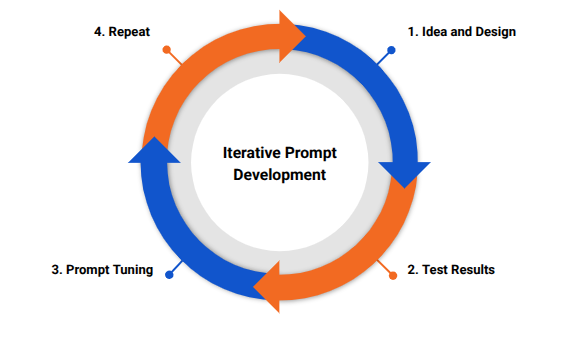
- Idea and Design: Create an initial prompt based on the desired outcome.
- Test Results: Review the AI’s response for accuracy and clarity.
- Prompt Tuning: Analyze the results, identify areas for improvement, and refine the prompt.
- Repeat: Keep testing and refining the prompt until you get the best result.
Prompting Techniques: Let’s explore a few prompting techniques that improve AI responses by making prompts more specific and effective. These methods guide the AI to handle complex tasks and deliver better results.
Zero-shot prompting: Zero-shot prompting is when you ask an AI to do something without giving it any examples or extra instructions. Basically, you’re letting the AI use its general knowledge to figure out how to respond to your question or task.
Example Prompt: “Generate test cases for a function that calculates the factorial of a number.”
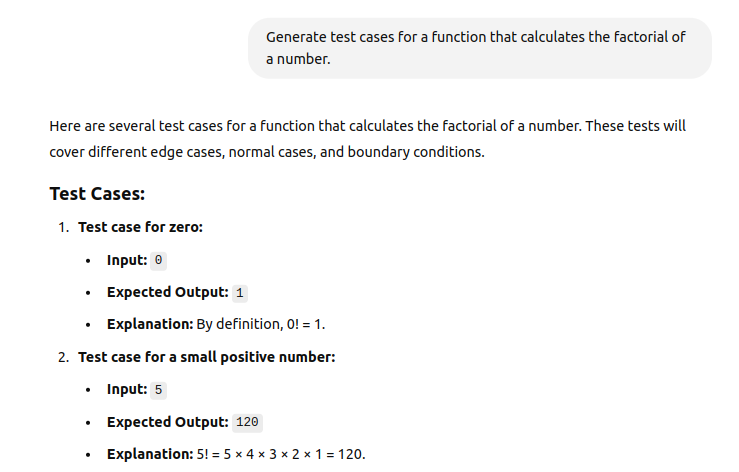
Few-shot prompting:
Few-shot prompting provides a small number of examples to help the AI model understand the task or context. These examples help the AI understand how to respond to similar tasks or questions, so it can give better answers based on what it learned from the examples.
Example Prompt:
“Classify the sentiment of the following sentences as Positive, Negative, or Neutral:
‘I’m so happy with my new phone!’ → Positive
‘This movie was boring.’ → Negative
‘It’s a cloudy day today.’ → Neutral
Now, classify: ‘The cake was delicious, I loved it!'”
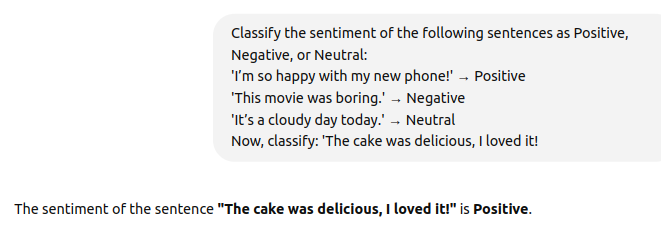
Self-consistency Prompting:
Self-consistency is a strategy where the model generates multiple outputs and then selects the most consistent one.
Example prompt: “Write two different Python functions that sort a list of integers in ascending order. Choose the one that is most efficient and correct.”
Response:
To sort a list of integers in ascending order, here are two different Python functions:
- Using Python’s Built-in sort() Method:
The sort() method sorts the list in place, modifying the original list.
def sort_list_builtin(lst):
lst.sort()
return lst
- Implementing Bubble Sort Algorithm:
Bubble sort is a simple comparison-based algorithm that repeatedly steps through the list, compares adjacent elements, and swaps them if they are in the wrong order.
def sort_list_bubble(lst):
n = len(lst)
for i in range(n):
for j in range(0, n-i-1):
if lst[j] > lst[j+1]:
lst[j], lst[j+1] = lst[j+1], lst[j]
return lst
Efficiency and Correctness:
sort() Method: This method is highly efficient, with a time complexity of O(n log n), and is the recommended approach for sorting in Python.
Bubble Sort: Bubble sort has a time complexity of O(n²), making it less efficient for large lists. It is primarily used for educational purposes to demonstrate sorting algorithms.
Conclusion:
The most efficient and correct method for sorting a list of integers in ascending order is using Python’s built-in sort() method.
Role-Playing Prompting:
This technique encourages the AI to take on a specific role or persona, such as an assistant, teacher, doctor, or engineer. This can help provide more context-specific and engaging answers.
Example Prompt: “Act as a booking assistant for a service-based business website. A user wants to schedule an appointment for a consultation. Walk them through the available timeslots and confirm the booking.”
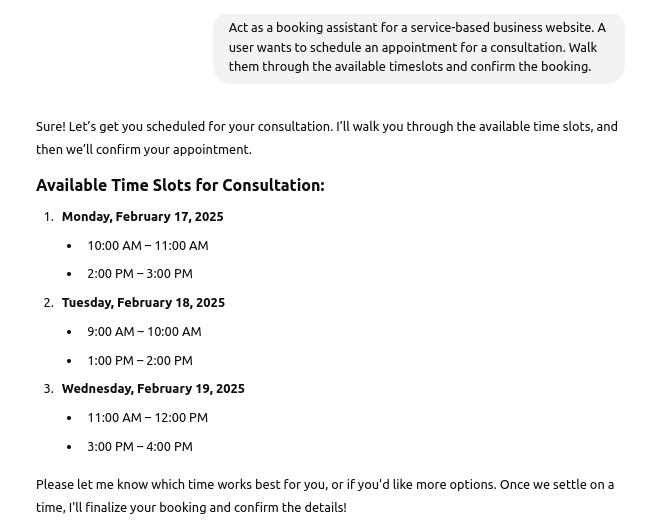
In Pearlbot(Techpearl’s chatbot solution), while creating prompts for various chatbots, we used role-playing to tailor the AI’s persona to specific domains like e-commerce or finance. This approach ensured the responses were relevant and suited to each industry’s needs, enhancing the overall user experience.
Least-to-Most Prompting:
This technique involves giving the AI information step by step, starting with simple or foundational details and gradually adding complexity. This approach helps the AI build a deeper understanding as it goes along.
Example:
Prompt-1: “Write a Python function that calculates the factorial of a number.”
Response:
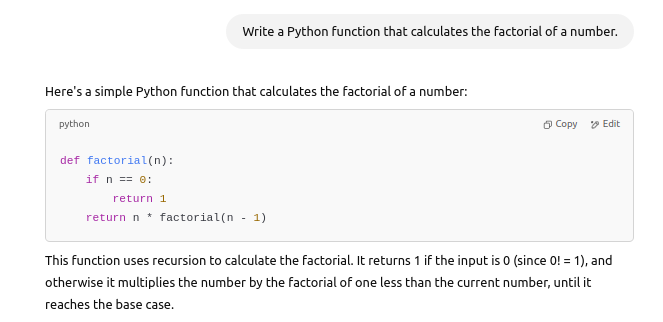
Prompt-2: “Now, modify the factorial function to handle negative numbers by returning None for negative inputs.”
Response:
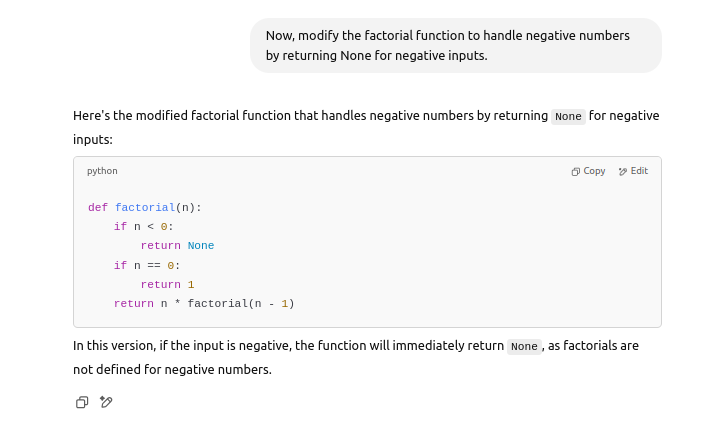
Prompt-3 : “Create a set of test cases for this function that covers positive numbers, zero, and negative inputs.”
Response:
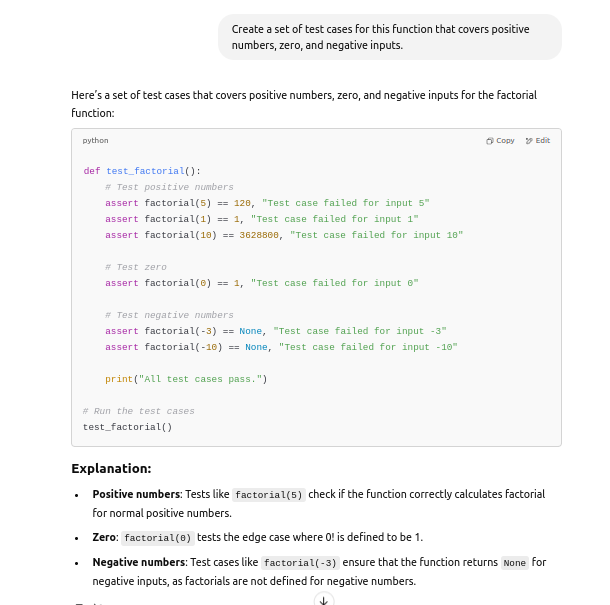
Prompt-4: “The factorial function works, but can you optimize the function for larger numbers to avoid deep recursion? Use an iterative approach instead.”
Response:
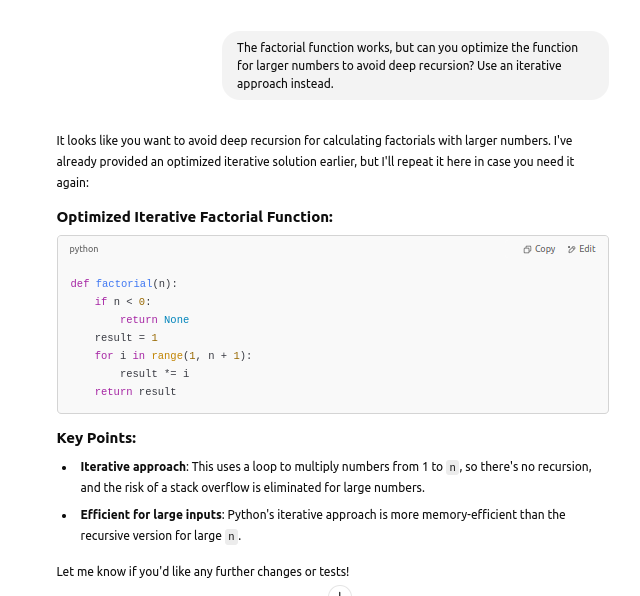
At Techpearl, we often use Least-to-Most Prompting for tasks like code generation, debugging, and generating test cases. This method helps break down complex coding tasks into manageable steps, ensuring a more structured and effective process.
Chain of Thought (COT) prompting:
Chain of thought (CoT) prompting is like giving the AI a roadmap to solve a problem step by step. Instead of jumping straight to the answer, it encourages the AI to think through each part of the problem, one at a time, which helps it solve more complex problems accurately.
Example Prompt :
“You are an EMI calculator assistant. When a user asks you to calculate EMI, follow these guidelines:
- Ask for the necessary details (loan amount, interest rate, and tenure).
- Explain the step-by-step process to calculate the EMI using the formula:
EMI = (P × r × (1 + r)^n) / ((1 + r)^n – 1) - Where:
- P is the principal loan amount.
- r is the monthly interest rate (annual interest rate divided by 12 and converted to a decimal).
- n is the number of months (loan tenure in years multiplied by 12).
- Show the calculation steps clearly:
- Convert the annual interest rate to a monthly rate.
- Calculate the number of months for the loan.
- Apply the formula to compute the EMI.
- Provide the final EMI amount with a clear explanation of the result.”
In Pearlbot(Techpearl’s chatbot solution), when providing chatbots for finance websites, we use CoT prompting to guide users through complex financial calculations like EMI. This step-by-step approach ensures clarity and helps users understand the entire process.
Constraint-based Prompting:
Constraint-based prompting is a technique where you set certain rules or limits for the AI’s response. This helps make sure the output fits specific requirements, like the format, content, style, or length you want.
Example Prompt: “Write detailed documentation for various AI prompting techniques. The documentation should include a Table of Contents and cover multiple techniques with their principles, use cases, examples, and benefits.”
Challenges in Prompt Engineering:
As a prompt engineer, just like a developer faces challenges while writing code, we also deal with a few difficulties when creating prompts for AI. Below are a few challenges I faced while fine-tuning prompts for chatbots:
- Poor Prompts Lead to Bad Results: Unclear or messy prompts lead to wrong or unhelpful answers. Keep prompts clear and simple for better results.
- Need for Domain-Specific Knowledge: When creating prompts for fields like shopping or finance, you need to use industry-specific terms to ensure the AI understands and gives accurate responses.
- Time-Consuming and Iterative Process: Creating effective prompts takes time and often involves trial and error. It requires ongoing adjustments and testing to refine the prompts and get the best results.
- Ensuring Website-Specific Responses: When a client wants the chatbot to only use their website data for answers, it can be hard to ensure the AI only uses that information. Sometimes, the AI may create its own answers instead.
- Dealing with Hallucination: Even with clear prompts, sometimes the AI can still create incorrect or made-up information when it doesn’t have enough details to answer properly.
- Addressing Ethical Concerns: If prompts are not used responsibly, they can lead to harmful or misleading content. It’s important to create prompts that are ethical and avoid spreading false information.
Ethical Considerations in Prompt Engineering
Prompt engineers need to make sure AI is used the right way. They should avoid creating prompts that lead to harmful, biased, or false information. It’s important to respect privacy, treat everyone fairly, and use AI in a responsible way that benefits everyone. Ethical prompt design helps build trust and ensures AI is used for good.
Conclusion
Mastering prompt engineering is key to unlocking the full potential of AI, enhancing its accuracy and effectiveness across various industries. By employing techniques like Role playing, Least to most , and chain-of-thought prompting, users can guide AI to generate more relevant and precise outputs. However, ethical considerations and iterative testing remain essential to ensure responsible and accurate AI usage.
Using pearlbot(Techpearl’s chatbot solution), we have successfully implemented these prompting techniques across various use cases, both for prompt creations and AI interactions, achieving optimal results. Through continuous refinement and testing of prompts, we’ve overcome challenges and consistently delivered high-quality outputs, ensuring that AI works efficiently and effectively for our clients.





